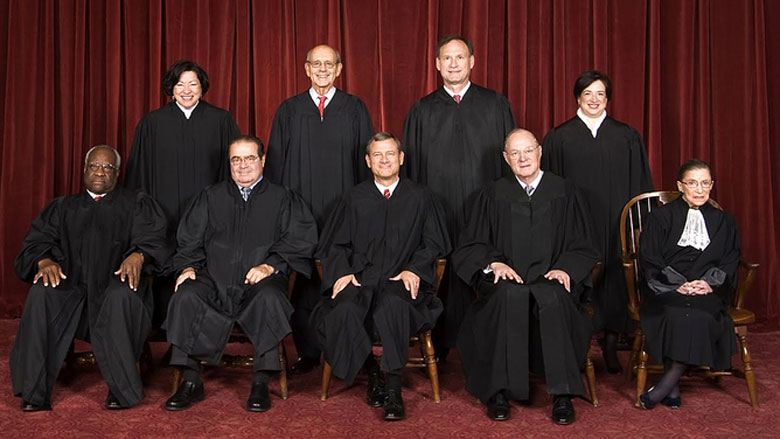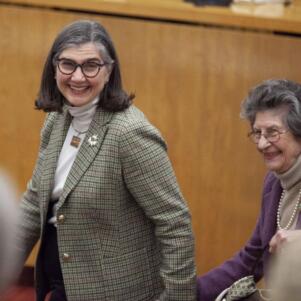Filling the Supreme Court vacancy: Lessons from 1968
By David Stebenne | February 26, 2016, 7:38 EST
 Who will join their ranks now – and when? (Steve Petteway/SCOTUS)
Who will join their ranks now – and when? (Steve Petteway/SCOTUS) United States Supreme Court Associate Justice Antonin Scalia’s death this month has created something of a dilemma – to put it politely – for the president and Congress.
Supreme Court vacancies are challenging to fill at the best of times, but an unexpected vacancy in the final year of a president’s term is especially tricky. And then add to that the particularly contentious relationship between the nation’s two major parties.
The clearest sign of that came this week, when Senate Majority Leader Mitch McConnell of Kentucky announced that the Senate would not consider any nomination made prior to the presidential election in November.
History offers a guide here, not just about what not to do but also about what might actually work.
The year was 1968
Some cite the seat that ultimately went to Anthony Kennedy in 1988 as the last time a president found himself asked to fill a vacancy during his last year in office. But that vacancy actually occurred in 1987, giving President Reagan and the Senate more time to work out a solution.
In fact, the last time the whole process took place during a president’s final year in office was in 1968, and it is a cautionary tale in more than one respect.
As GOP presidential candidate Richard Nixon gained ever more momentum in the spring of that year, then-Chief Justice Earl Warren began thinking about retiring from the court, so as to give President Lyndon Johnson the chance to replace him.
Warren’s motives here were both personal and political.
He and Nixon had clashed back in 1952, when then-Governor Warren of California sought the GOP presidential nomination, and then-Senator Nixon worked actively to undermine Warren’s support in the California GOP delegation.

Earl Warren, Supreme Court Chief Justice (1953-1969). Harris & Ewing, Harvard Law School
Warren by then had come to see Nixon, as so many others did, as a devious opportunist with character flaws so serious as to make him a poor candidate for higher office.
Warren was also alarmed by Nixon’s attacks in 1968 on the Warren Court as being insufficiently protective of “law and order.” He was also perturbed by Nixon’s pledge to appoint justices to the court who would overturn Warren Court rulings that strengthened protections for criminal suspects and defendants.
Warren, who turned 77 in March 1968, thought he was unlikely to outlive a Nixon presidency (he didn’t), and so wanted to deny Nixon the chance to name Warren’s successor for all of these reasons.
When the Democrats’ most promising candidate to oppose Nixon, New York Senator Robert Kennedy, was killed on June 4, leaving Nixon with a clear path to victory in the fall, Warren decided to go through with his plan.
Warren and Johnson against Nixon
On June 13, 1968, Warren went to see Johnson and informed him that as soon as a successor was confirmed by the Senate, Warren would retire.
Johnson, motivated by the same desire to deny Nixon and the Republicans the sort of “law and order” justice that they wanted, promptly nominated his old friend and aide Abe Fortas, who was then serving as an associate justice, as chief justice. (To fill the seat Fortas would be vacating, Johnson nominated another Texas crony, former Congressman Homer Thornberry.)
The result was a complete fiasco.
The Republicans, though in the minority in the Senate then, rallied to oppose what they saw as a blatantly political scheme to deny Nixon the kind of choice he favored should he be elected.
Conservative Southern Democrats agreed, and by joining forces with the Republicans in the Senate, succeeded in blocking Fortas’ nomination.

LBJ and Abe Fortas confer in the Oval Office in July 1968. Yoichi Okamoto
And by subjecting Fortas to a round of highly contentious confirmation hearings, Johnson also made matters even worse from his perspective. When it emerged that Fortas had accepted a “privately funded offer to teach at American University,” support for his appointment evaporated. Johnson withdrew the nomination, and eventually Fortas resigned from the court in May 1969, thereby giving Nixon not one but two early appointments to the court.
The clear lesson of the Fortas fiasco was not to pick a nominee of the sort that the opposition party and its presidential candidate would strongly oppose.
That’s even more true today, because the movement of conservative white Southerners into the Republican Party since 1968 has led to an outright GOP Senate majority, which was not true in 1968.
And now in 2016…
Now the Republicans have formal control over the Senate Judiciary Committee, which vets Supreme Court nominees, and over the larger Senate itself, the body that must confirm them. They are, in other words, in an even better position to block a nominee to whom they object than they were in 1968.
The clearest sign that they intend to try is the recent, unprecedented announcement that the GOP leadership in the Senate won’t permit anyone to be considered until after the presidential election. Thus, unless something dramatic and unexpected happens to change the terms of partisan debate on this issue, no nomination can be approved this year.
All of this suggests that President Obama, if he wants to have any hope of getting a nominee confirmed before the November election, should pick someone acceptable to a majority of the Senate Republicans.
If Obama did that, the principal rationale for GOP obstructionism in the Senate would disappear. Sticking with their refusal even to consider such a nominee might result in so much public outcry as to persuade the Senate Republican leadership to change course.
The most likely approach would be to choose someone from the U.S. Courts of Appeals (or from a state Supreme Court) who was a Republican appointee to that post.
This choice would have to be, however, also acceptable to Senate Democrats. Thus, such a nominee would also have to possess a centrist and uncontroversial record as a judge.
David Stebenne, Professor of History and Law Faculty, The Ohio State University
![]()









